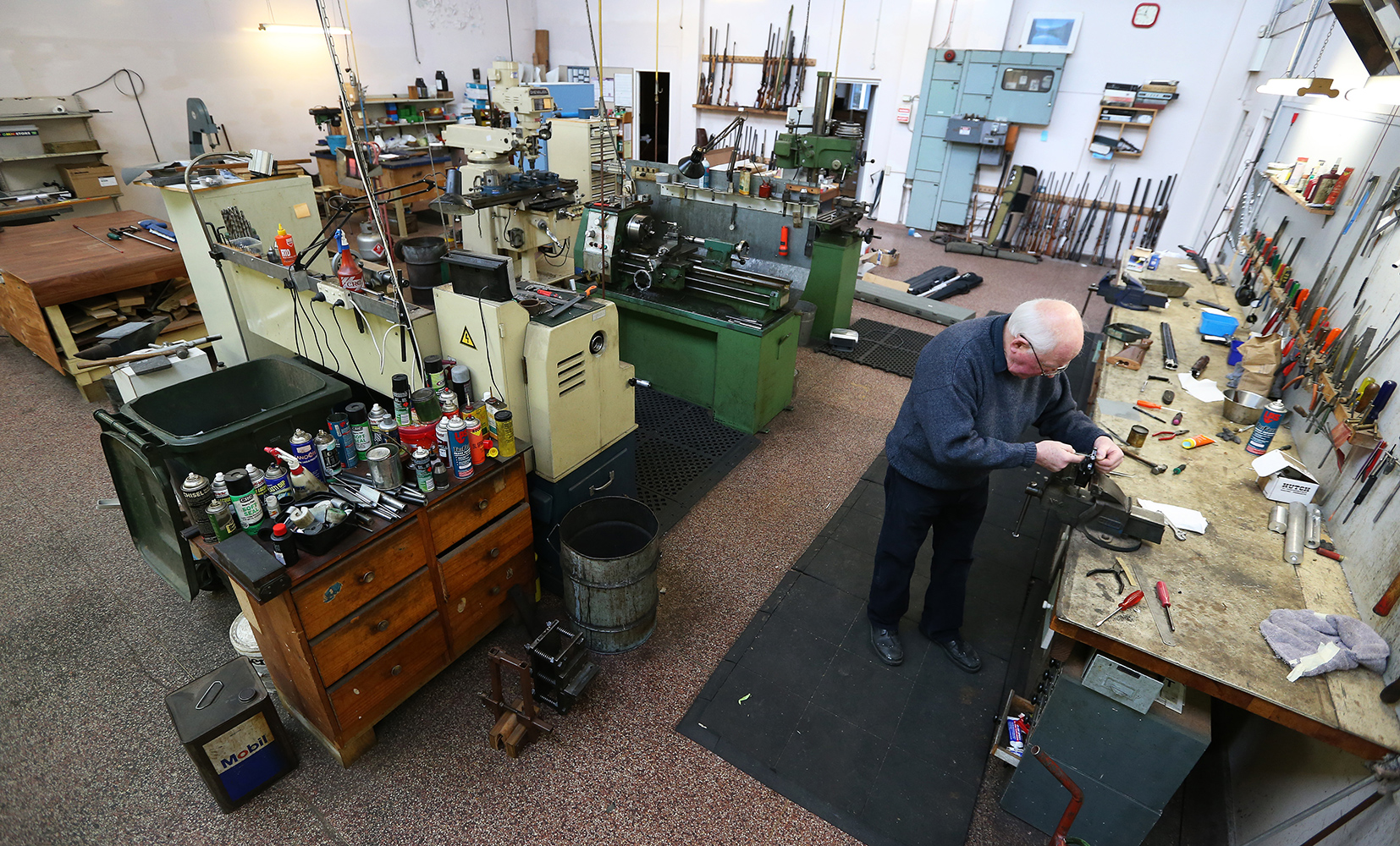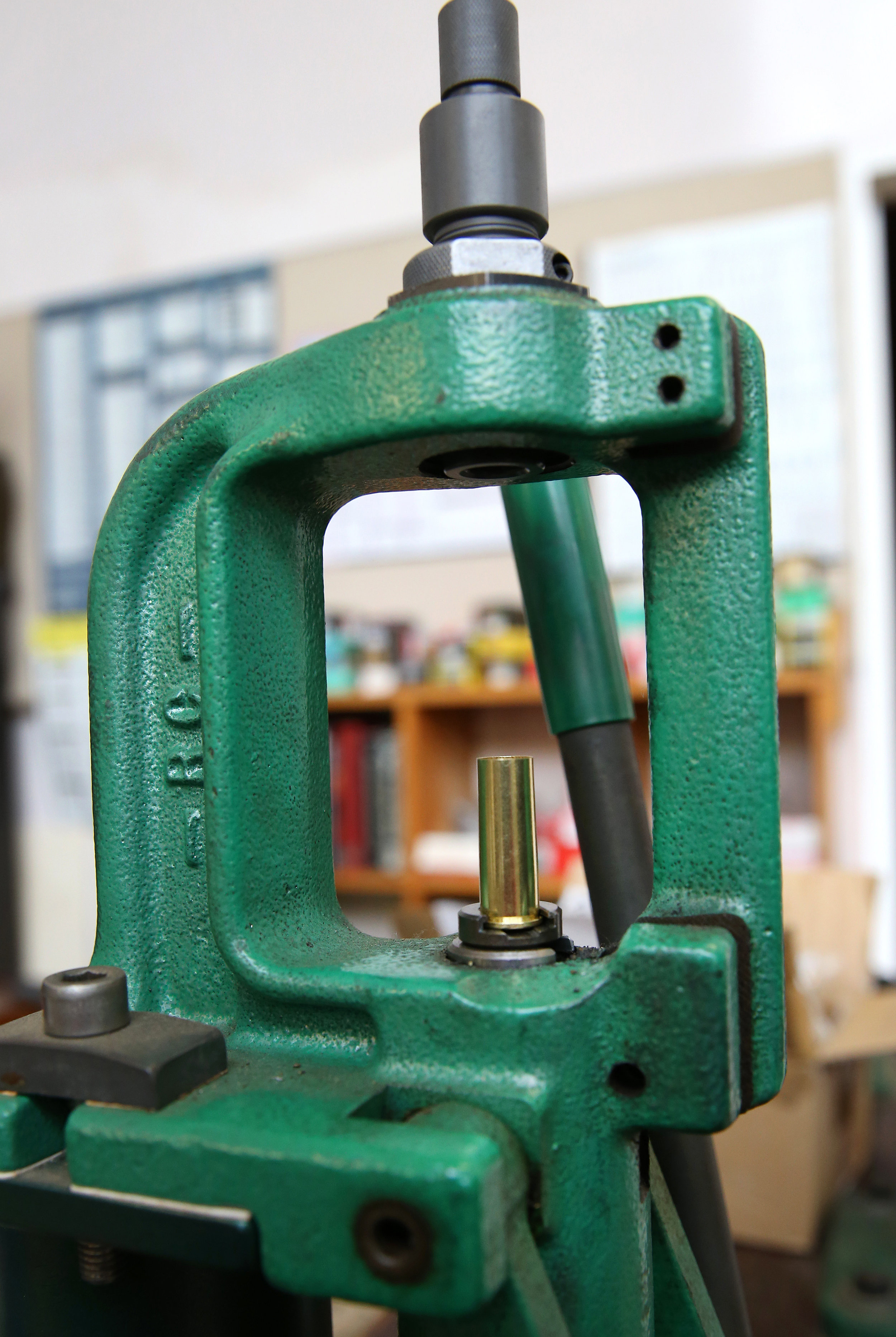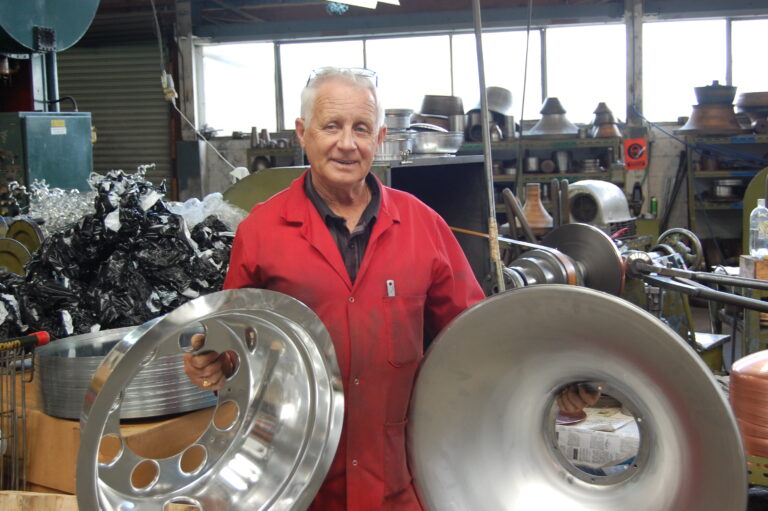The wide world of Invercargill gunsmith Nelson Collie
A natural bent for engineering made the transition from farming to gunsmithing easy for Invercargill gunsmith Nelson Collie. It was a career change that has earned him and his business, Status Guns and Engineering, an international reputation for innovation and high-quality workmanship. Nelson left secondary school back in the mid-1950s and joined his father on the family’s 121-ha sheep farm about 40 km north-west of Invercargill. Nelson recalled that while back then it had been expected that farmers’ sons would follow in their Photographs: Robyn Edie, John Cutt, Paul Mulligan fathers’ footsteps, for the most part it had not been a happy relationship. After two years working alongside his father, Nelson set off for Lincoln College where he completed a diploma in agriculture and in the process discovered he had natural engineering ability. “I did particularly well and topped the class and discovered that was what I really liked doing.” On returning home, Nelson said he became disenchanted with farm life. “It wasn’t as much fun as it had been. In the early ’60s there was a climate change that made farming harder, [product] prices for everything went down and it looked like it [farming] was falling apart.” That, plus on-going difficulties working with his father, forced Nelson to look beyond the farm for a career. During lulls in farm activities he had done occasional engineering work for local engineering firms and neighbours that included repairing hunting rifles. “I had heard of an organisation called Project Concern which ran hospitals in Hong Kong, Vietnam, the poorer parts of the Appalachians in the US and in Central America.” An inquiry resulted in an appointment to a hospital in Vietnam (during the Vietnam war) where he maintained everything from operating theatre equipment to vehicles, plumbing and wiring, in fact, “everything that broke down.” On bad days he did occasional undertaking and even minor surgery. The experience had left a lasting impression. “It affected me personally and gave me a greater feeling for humanity and a distaste of politics. War is man’s greatest evil and is always instigated by politicians,” he said. It would seem Nelson’s distaste for war is somewhat at odds with his chosen profession as a gunsmith. “It is how they (guns) are used that is the problem, not what they are,” he says. It is the engineering and mechanical side of guns that attracts Nelson. Gunsmithing is 99 percent engineering with cosmetic overtones, he said. There is not much of a challenge in making a hay barn except to ensure it is strong, whereas building firearms allow engineers to take their skills to their limits, he said. On returning home from the war, Nelson continued farming for about ten years before deciding to sell the farm and become a full-time gunsmith. Having had some gunsmithing experience while on the farm, he took that direction—a direction that, considering he had no interest in hunting, “might seem a bit unusual,” he said. Soon interest and commissions were flowing in from customers from all over New Zealand and he moved into town, leasing a premise for several years and eventually buying one outright. His natural aptitude, plus extensive reading and a willingness to experiment has contributed to Nelson’s success.
Prone target rifle
Nelson often receives requests to make one-off guns to clients’ specifications. One such request was to build a prone target rifle for one of Australia’s top female target shooters, Kathryn Blain (nee Lange). The former Southland woman had taken up the sport of prone target shooting soon after moving to Darwin with her husband Daniel in February last year. For the past year, Kathryn had been borrowing a rifle, but she now wanted one of her own, Nelson said. Kathryn’s only specifications were the colour of the stock and the brands of certain components to be used in the rifle’s construction. The 308 calibre rifle has been constructed using componentry sourced from around the world, including a Barnard action from Auckland, a McMillan prone stock and a Warner sight from the USA and a Palma barrel from Walthers in Germany. As part of the sport’s requirements, the rifle does not have a scope, but rather has conventional open sights with a capacity to see 1000 metres without magnification. The adjustable sights can move horizontally and vertically and are very precise, he said. Nelson estimated the rifle would take about 50 hours to make.
Net guns
A large part of the business is now the design and manufacture of net guns. The guns were designed initially for live deer capture in the heyday of deer capture back in the mid to late 1980s. But he doesn’t take credit for being the first to develop the idea. Many years later he discovered that a chap on the West Coast had actually come up with the concept but was unable to protect it by copyright and others, notably helicopter operators, had copied it. At first he built net guns for helicopter operators and developed some of his own designs, which became recognised as an efficient and humane method of capturing live animals. With the net-gun activity booming, Nelson split the business in two. Status Guns continues to design and manufacture made-to-order guns and Ace Capture Equipment Ltd concentrates on the development and marketing of net guns. Net guns are now produced in a variety of styles and sizes according to the target species and customer requirements. “We’ve made types that can be mounted on a vehicle or post, or suspended from a cable tied between two trees which can be fired by a baited trigger, by a long line pulled by an operator or from several kilometres by radio control.” Species-specific devices have proved particularly useful for capturing sick or injured animals, or animals which, for whatever reason have to be moved to a new location. The numbers sold thus far are listed in the hundreds. Models have been sold to Greece for capturing wolves, a university in Poland to capture for research purposes a small ferret-like animal that has been linked to spreading bird flu and for pigeon capture in cities where pigeons are an issue. Although he hadn’t yet been asked to develop a net device for elephants, inquiries have been made for one specific for giraffes, Nelson said. One net gun, made 30 years ago is still being used by a Te Anau deer-capture operator. With customers who requested unusual guns for unusual purposes, gunsmithing was always a challenge, Nelson said. “But I always say, ‘Why not?’” Guns requested by customers who require standard-type, sporting or accuracy target rifles are designed and built from parts made by both Status Guns and other specialist manufacturers. The guns are finished with imported Kevlar or fibreglass stocks, or, if a client wants a specific style of wooden stock, from a stockmaker. “It all depends on what the customer wants,” Nelson said. Firearms or parts that are not readily available are made from scratch, apart from barrels which are sourced from specialty barrel makers in either Australia or Germany. At least 50 percent of the barrels Status Guns uses are stainless steel which is more resistant to rust than blued steel. “In Southland, Stewart Island and Fiordland, because of the weather, stainless steel barrels have a considerable advantage.”
Silencers
Nelson began getting requests to reduce the sound of hunting rifles about 30 years ago. Fitting silencers to firearms, especially small-calibre guns such as a .22 is common enough, but fitting out larger calibre, high performance rifles is another thing. Initial development was based on both silencing the muzzle blast and using subsonic ammunition to eliminate the sonic “crack”. In order for a bullet to kill humanely at subsonic velocities, it has to be very heavy and therefore big in diameter. “To get rid of the sonic crack we had to slow the bullet down to less than the speed of sound and unless it was a very big bullet it was ineffective. Smaller bullets just bounced off the animal.” Nelson explained that at slower speeds it was the weight of the bullet rather than its speed that did the damage. “At close range, if the bullet is heavy enough, the lack of speed doesn’t matter.” This type of ammunition is effective at short ranges only and is not of interest to most hunters. A few, particularly pig hunters using dogs, favour this totally silent arrangement because it does not damage the dogs’ hearing. The sonic crack of a high-velocity bullet was not all that important, he said. The actual blast from the rifle caused by the explosion of gases as the bullet exited the barrel was what scared the target animal. “The sonic crack is un-directional and animals don’t know which direction it’s coming from and sometimes even run towards it,” he said. But customers still wanted a completely silent gun. The result is a short-barrelled gun that fires a heavyweight bullet that is slow enough to be seen in flight. It is so effective that the bullet is capable of piercing two railway sleepers. Because these rifles fitted with a silencer make virtually no noise at all, they are suited to hunters who prefer to use their stalking skills to get as close to the target as possible, he said. More recently, sound suppressors on rifles using standard supersonic ammunition have become extremely popular. While considerable noise is still generated, it is vastly reduced. Nelson started developing sound suppressors made from carbon fibre and titanium about two years ago. Not only are carbon fibre sound suppressors lightweight, weighing about 0.3 kg, but they are also stronger than steel and incredibly effective at reducing sound, he said.
Blank cartridges
A small, but specialised part of Nelson’s business is producing blank cartridges which have a variety of applications. The energy produced when a blank cartridge is fired is sufficient to deploy net guns and to start diesel engines, particularly vintage Lanz Bulldog tractors, which are too big and heavy to be turned over by hand. Blank cartridges are also used in starter guns for yacht races because the “tremendous bang” it produces carries a long way. Captive bolt guns used in freezing works to kill cattle and deer for slaughter use blank cartridges to propel the bolt into the animal’s skull. Nelson does not make the cartridges for captive bolt guns, but he does service the guns used in Southland, Westland and some Otago freezing works. A cable-cutting device used by electrical service companies to cut potentially live underground cables also uses blank cartridges. As some of the industrial maps recording the location and use of cables can be somewhat vague, cable cutting blanks are a safe and efficient way to cut cables that may be live, he said. The cable cutting device is clamped around the cable and when the cartridge is fired it drives a chisel-shaped cutter through the cable. Nelson does not make the cable-cutting devices, but he does make the blank cartridges and chisels used in the device. Status Guns also makes star-crimp dies for closing blank cartridges and exports them worldwide to enable net gun users to make their own cartridges, as it is extremely difficult and expensive to transport ammunition of any sort, he said. One of his more unusual commissions was a contract several years ago to a Bollywood movie being made in the Queenstown area. “It involved a lot of blank ammunition and ammunition that made smoke.” The nature of the contract required that a person with a licence to legally possess fully automatic weapons and pistols, had to be on the set all day, every day. Nelson described the experience as both “interesting and frustrating.” Modifying Lee Enfield .303 rifles to accept other calibres is something Nelson has made a specialty of. One of the more unusual requests was for the design and manufacture of “huge” rifles capable of firing 50-calibre or larger 14.5 mm and 20 mm cartridges. In recent years, Status Guns has been involved in some development work for American military contractors that has involved a number of trips to the USA to demonstrate his ideas to the US military. Such development was on-going, he said. Nelson recently received a commission from a Christchurch gun enthusiast to make a 20mm single shot gun from the barrel of an anti-aircraft cannon, originally sourced from navy surplus. Nelson was unable to make the barrels using his equipment, but he was able to make the stocks, actions and muzzle brakes. As he has 20 mm loading dies, Nelson is also able to make the ammunition. But Status Guns is not just about firearms. Nelson’s engineering skills are also sought after by customers wanting vintage car parts, developing prototypes for inventors, making and repairing unusual machinery for industrial use, equipment made to order for disabled persons and the maintenance of the projectors at Invercargill’s Readings movie theatre. A ballistic forensic advisory service is also available. Status Guns and Engineering has clients in Africa, Argentina, Australia, Bahrain, Canada, Hungary, Papua New Guinea, Tahiti, United Arab Emirates, United Kingdom, United States of America and Zambia. Ace Capture also has agents in Australia and the USA.












